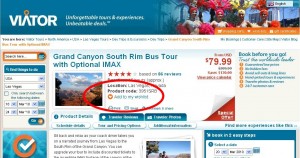Wish Lists Lift Conversions
Personal travel arrangements often require coordination with other parties, whether it’s your spouse, friends or other family members. That’s why travel activity retailer Viator’s sharable wish lists are such a great idea.

Many ecommerce sites offer wish lists to visitors. They’re especially useful during the holiday season when families are figuring out what to buy one another. The impression I’ve gleaned from marketers is wish lists are useful, but they’re not a strong ongoing performance driver.
Online travel, on the other hand, has a more practical application for wishing. Friends and family members going on trips often coordinate what to do and send each other ideas. Viator’s wish lists make it easy for travelers to share ideas, and the team places “Add to my wish list” links prominently on their product pages.
I noticed these lists during a conversation with Kelly Gillease, Marketing Director, Viator. Visitors can view items on their wish lists directly on the homepage. From the homepage, with one click, they can view a form to send the list to up to three people with a personalized message.
“We do get a fair number of people creating wish lists, emailing them and sharing them,” Gillease says. “We’ve found it really does help boost our conversion rates.”
Gillease’s team plans to build on this success by creating account pages where site visitors can view all their lists, among other features.
Are there other effective applications for wish lists that you’re seeing? Are they helping lift your conversion rates? Let us know in the comments, and thank you.








